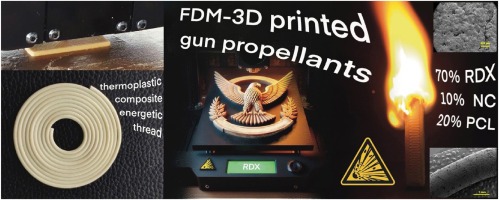El trabajo de la referencia explora la fabricación aditiva de materiales energéticos, centrándose en la impresión 3D de propulsantes para armas de tubo utilizando la tecnología de modelado por deposición fundida (FDM). Se destaca la aplicación de FDM a propulsantes para armas, ya que no se había informado anteriormente. El estudio demuestra el potencial de la impresión 3D FDM en la producción de compuestos energéticos de alto rendimiento y tiene como objetivo establecer un nuevo estándar para la fabricación en este campo. Los compuestos termoplásticos desarrollados contienen una alta proporción de sólidos energéticos, con un 70% de hexógeno (RDX) y un 10% de nitrocelulosa (NC), superando los límites convencionales. El objetivo principal del estudio fue optimizar la formulación, mejorar el rendimiento y equilibrar la capacidad de impresión con la eficacia del propulsante. Entre las tres formulaciones desarrolladas, la que consta de un 70% de RDX, un 10% de NC y un 20% de policaprolactona (PCL) fue la más adecuada como propulsante de armas debido a su excelente procesabilidad, capacidad de impresión y rendimiento energético.
This study represents an important step forward in the domain of additive manufacturing of energetic materials. It presents the successful formulation and fabrication by 3D printing of gun propellants using Fused Deposition Modeling (FDM) technology, highlighting the immense potential of this innovative approach. The use of FDM additive manufacturing technology to print gun propellants is a significant advancement due to its novel application in this field, which has not been previously reported. Through this study, the potential of FDM 3D-printing in the production of high-performance energetic composites is demonstrated, and also a new standard for manufacturability in this field can be established. The thermoplastic composites developed in this study are characterized by a notably high energetic solids content, comprising 70% hexogen (RDX) and 10% nitrocellulose (NC), which surpasses the conventional limit of 60% energetic solids typically achieved in stereolithography and light-curing 3D printing methods. The primary objective of the study was to optimize the formulation, enhance performance, and establish an equilibrium between printability and propellant efficacy. Among the three energetic formulations developed for 3D printing feedstock, only two were suitable for printing via the FDM technique. Notably, the formulation consisting of 70% RDX, 10% NC, and 20% polycaprolactone (PCL) emerged as the most advantageous option for gun propellants, owing to its exceptional processability, ease of printability, and high energetic performance.
![]() Fuente: https://www.sciencedirect.com
Fuente: https://www.sciencedirect.com


